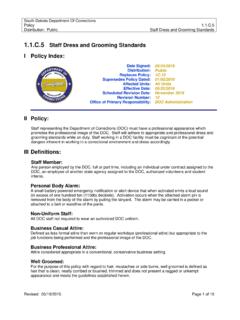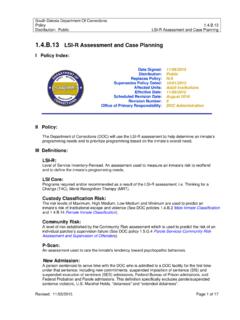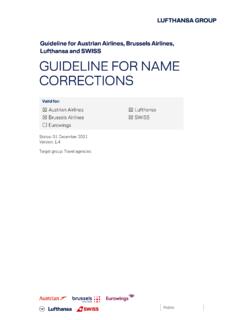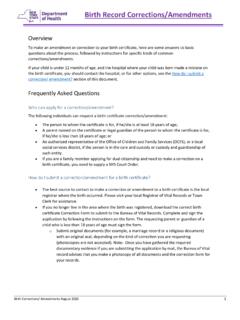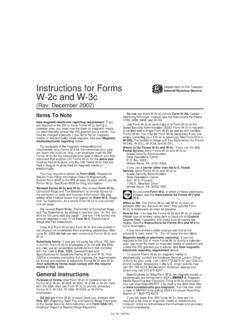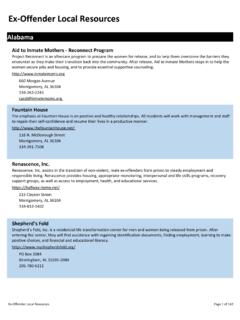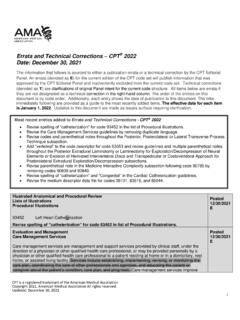Transcription of Corrections Glossary of Terms - South Dakota Department of ...
1 1 Corrections Glossary of Terms This is a collection of Terms commonly used in our agency policies and procedures. See the DOC policies for the definitions that apply to those specific policies. Absconder- Any parolee under the supervision of the Parole Services Division (on parole and/or suspended sentence) whose whereabouts are unknown to the supervising Parole Agent. A parolee is considered an absconder once efforts to locate the parolee have been exhausted and failed. Abuse- Any act or failure to act by an employee of a juvenile Corrections facility or by a contract person or entity providing services to a juvenile Corrections facility, which act was performed or was failed to be performed, knowingly, recklessly, or intentionally, and which caused, or may have caused, injury or death to an individual in the custody or care of a juvenile Corrections facility (See SDCL 26-11A-24).
2 Administrative Detention- A temporary form of separation from the general population used when the continued presence of an inmate within the general population would pose a threat to life, property, self, staff, or other inmates; or to the security or disciplined operation of the institution. Administrative Segregation- A status designated for inmates who have not responded to counseling or conventional disciplinary sanctions, who are flagrantly or chronically disruptive to the good order and disciplined operation of the institution, or who pose a threat to the security of the institution (may include those inmates with a capital punishment sentence).
3 Administrative segregation is not a disciplinary sanction or a punitive status. Adult Internal Management System (AIMS)- A classification tool designed to identify and separate male inmates based on observed behavior into homogeneous living groups as an effective management tool to reduce friction, violence, and disruptive behavior. Aftercare Contract- An individualized legal contract that establishes the conditions of supervised release for juvenile offenders. Aftercare Plan- An individualized program plan utilizing the YLS/CMI as a guide. The aftercare plan targets a juvenile s areas of need and prepares him/her for progressively increased responsibility and freedom in the community.
4 Average Daily Count (ADC)- The number of inmates within a prison system on any given date. 2 AWOL- Absent Without Leave. The failure of a juvenile to return to a facility from approved leave. Body Alarm- A wireless device issued to staff and individuals prior to entering the secure perimeter of an adult DOC facility that clips to the belt or pants and emits a loud alarm when activated by a pull chain. Case Management Risk Level- A level of risk established by the LSI-R risk, age, release plan and/or release type which is used to determine a minimum number of contacts a case manager will have with an offender during a timeframe.
5 Case Plan- A defined set of requirements, expectations and/or goals for an offender to complete during their incarceration. Case Plan Database- A database used by staff to track assessed needs, casework steps, and case notes for offenders in the Second Chance Act treatment group. Offenders in the SCA control group or offenders who have opted out of the study will have demographic information stored in the database. The use of this Case Plan database to support intensive case management is a part of the treatment for treatment group offenders. Child In Need of Supervision (CHINS)- As defined by SDCL 26-8B-2, a Child In Need of Supervision is: Any child of compulsory school age who is habitually absent from school without legal excuse; Any child who has run away from home or is otherwise beyond the control of the child s parent, guardian or custodian; Any child whose behavior or condition endangers the child s own welfare or the welfare of others.
6 Any child who has violated any federal, state, or local law or regulation for which there is not a penalty of a criminal nature for an adult, except violations of subdivision 34-46-2(2) (to purchase or attempt to purchase, to receive or attempt to receive, to possess, or to consume a tobacco product if a person is under the age of eighteen); or Any child who has violated 35-9-2 (purchase, possession or consumption of beverage by minor as misdemeanor) or 32-23-21 (person under the age of twenty-one (21) operating a motor vehicle with .02% or more of alcohol in their blood, or marijuana or any controlled drug present in the person s body).
7 Class I Visit- A contact visit conducted in a visiting room or designated visiting area of a SD DOC facility. Class II Visit- A non-contact visit conducted in a glassed-off area in a visiting room or designated visiting area of a SD DOC facility. 3 Classification- An offender is classified for a particular security level and housed in an appropriate facility based on assessment of their crime, security risk and prison behavior. Community Corrections Specialist- A DOC staff designated to manage the DOC Foster Care Program, recruit and train foster care parents, monitor the quality of care provided to foster care youth, and serve as a liaison between the DOC Foster Care Program and Juvenile Community Corrections .
8 Community Risk- A level of risk established by the Community Risk assessment which is used to predict the risk of an individual parolee s supervision failure. Community Service- A program that allows inmates to work in the community and that provides low cost labor to State agencies, federal and local governments (county, township, city), and non-profit organizations, pursuant to SDCL 24-4-7. Special consideration may be given to short-term projects for private property owners who are elderly or disabled. Community Transition Program (CTP)- A program designed to assist offenders with a successful transition to community supervision.
9 Community Transition Program (CTP) Absconder- A group 1, 3, or 4 CTP offender (placed in CTP directly from the institution) on phase one (restricted to the unit) who leaves their unit without authorization (See DOC policy Community Transition Program). Comprehensive Offender Management System (COMS)- A DOC database for staff use in the management, storage and collection of informational and statistical data. Conditions of Confinement- Lawsuits that allege in their initial pleadings that an agent, employee or officer of the South Dakota DOC is holding the inmate-plaintiff under circumstances or conditions that violate rights under the US Constitution.
10 Conditional Release- The release of an offender to parole or suspended sentence supervision, or the temporary release of an offender on a furlough, bedside visit or funeral attendance. Contraband- Any item(s) introduced or found in the facility, including improperly possessed drugs (whether illegal or legal) and weapons, that are expressly prohibited by those legally charged with the responsibility for the administration and/or operation of the facility. Contraband includes, but is not limited to: 1) Items not issued to an offender by the institution(s). 2) Inmate personal property obtained through means not prescribed by or in excess of policy.

